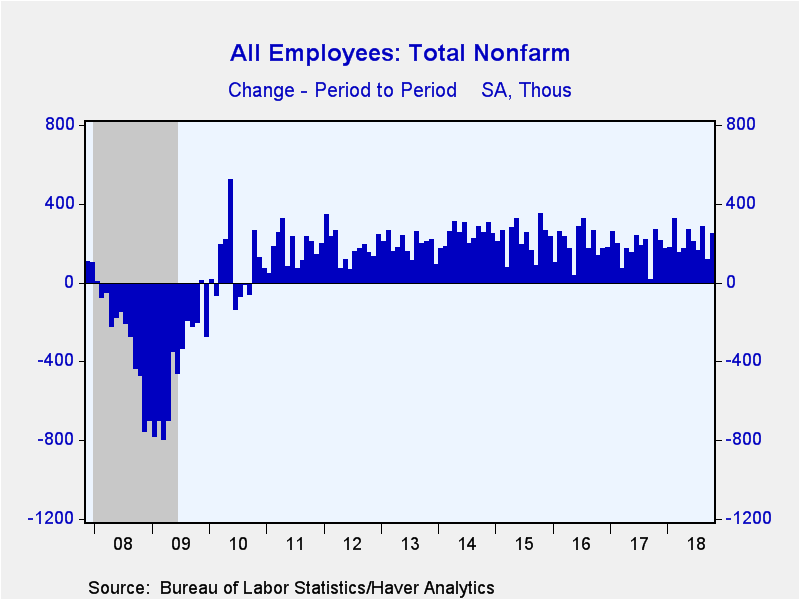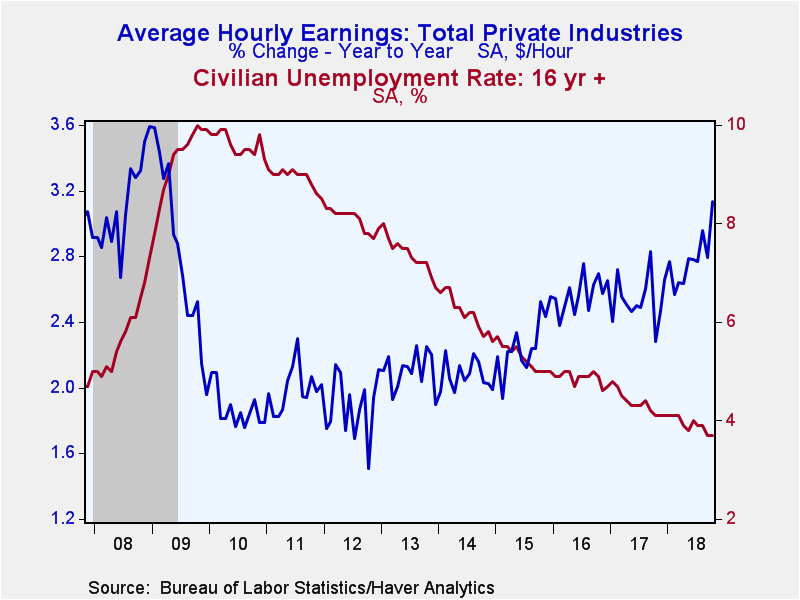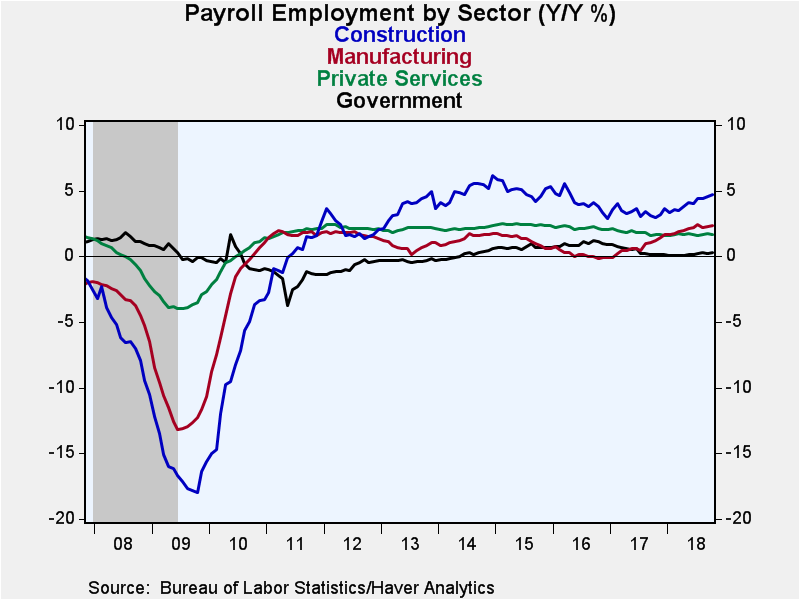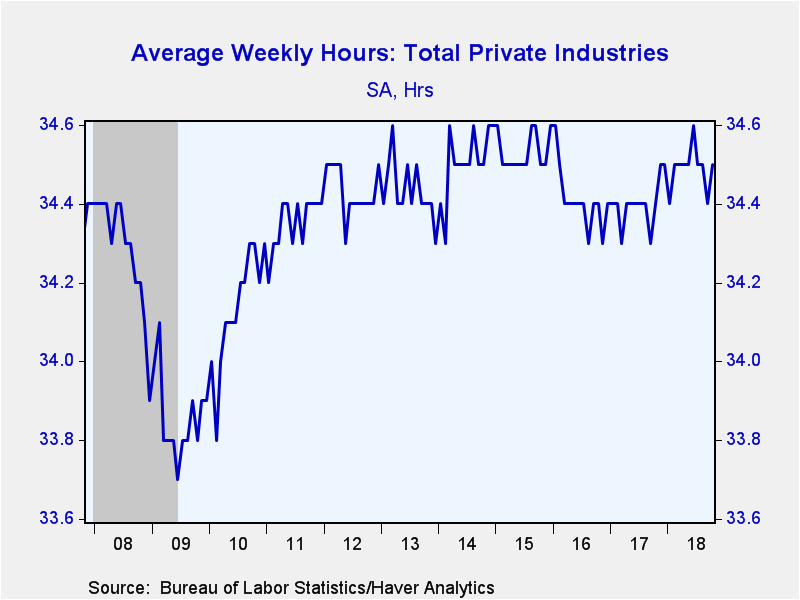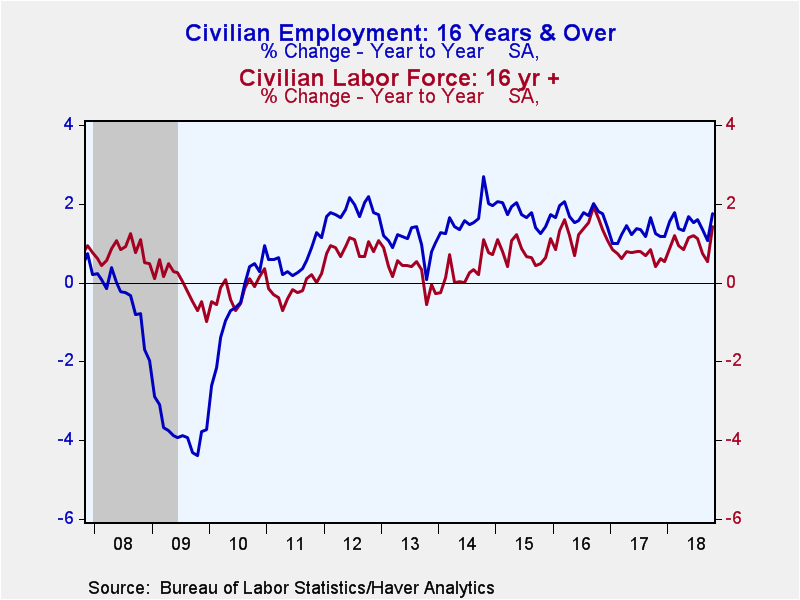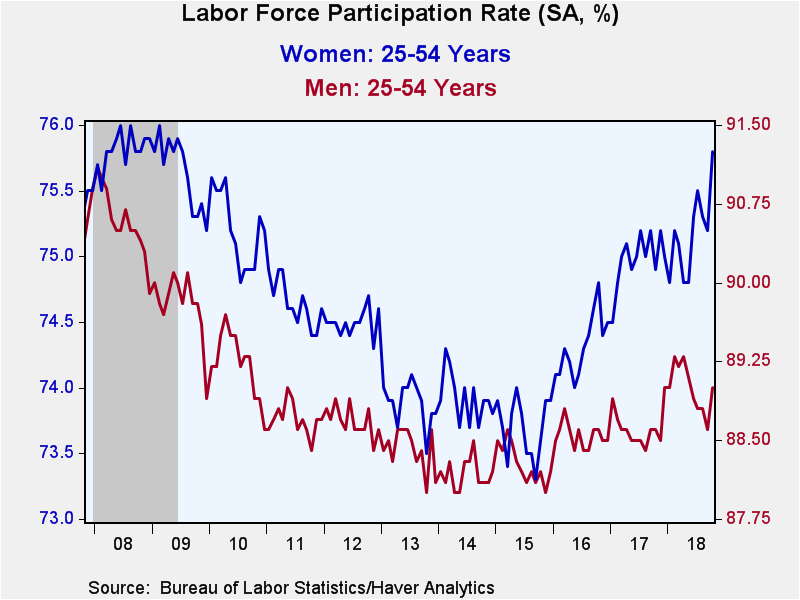 Global| Nov 02 2018
Global| Nov 02 2018U.S. Job Growth and Worker Earnings Strengthen
by:Tom Moeller
|in:Economy in Brief
Summary
The labor market is robust, strong enough to lift workers' pay. Average hourly earnings increased 0.2% during October and raised the y/y increase to 3.1%, the strongest gain since April 2009. The rise matched expectations in the [...]
The labor market is robust, strong enough to lift workers' pay. Average hourly earnings increased 0.2% during October and raised the y/y increase to 3.1%, the strongest gain since April 2009. The rise matched expectations in the Action Economics Forecast Survey. Nonfarm payrolls increased 250,000 (1.7% y/y) following a 118,000 September gain, revised down from 134,000. The gain in August payrolls was revised up, however, to 286,000 from 270,000. A 190,000 rise had been expected. The unemployment rate held at an expected 3.7%. It was the lowest rate since December 1969.
From the establishment survey, the 0.2% increase in average hourly earnings followed an unrevised 0.3% September rise. The August increase was revised up to 0.4% from 0.3%. Strength in private service-producing industries was robust. The 0.2% increase in earnings increased the y/y rise to 3.3%, up from 2.1% in each year from 2010 to 2012. Information sector earnings gained 0.2%, lifting the y/y increase to 5.2%. Earnings in the financial sector held steady and the y/y increase eased to 4.1% from its January high of 5.3%. Leisure & hospitality compensation rose 0.2% as the y/y increase strengthened to 3.4%. Trade, transportation & utilities earnings also gained 0.2% and surged 3.3% y/y, a rise from 2.2% one year ago. Earnings in professional & business services rose a steady 0.2% m/m and an improved 3.1% y/y. Education sector earnings also rose a steady 0.2% (3.4% y/y).
The 250,000 rise in payroll employment was above the 213,000 average for the first ten months of this year. That compared to a 182,000 monthly average in 2010. The recent gain reflected a 67,000 increase (3.3% y/y) in goods-producing jobs. Factory sector employment rose 32,000 (2.3% y/y), the strongest gain since December. Construction sector jobs rose an improved 30,000 (4.4% y/y). Employment in the mining sector increased a steady 5,000 (10.1% y/y).
Private service sector employment rose 179,000, a gain led by a 44,000 rise (2.1% y/y) in education & health service sector jobs which followed a 26,00 improvement. Leisure & hospitality employment followed with a strengthened 42,000 increase (1.6% y/y). Employment here held steady in September due to Hurricane Florence. Jobs increased 37,000 (1.1% y/y) in trade, transportation & public utilities after an 8,000 decline. Professional & business service sector jobs followed with a 35,000 improvement (2.6% y/y). Temporary help employment rose 3,300 (2.3% y/y) following three months of stronger increase. Jobs in the finance sector improved a lessened 7,000 (1.4% y/y) and information services sector employment also rose 7,000 (-0.3% y/y) following declines in three of the four prior months.
Government sector employment improved 4,000 as local government hiring improved 2,000 (0.5% y/y) after a 5,000 decline. Jobs in the federal government improved 1,000 (-0.1% y/y) as they did in five of the previous six months. State government employment also rose a lessened 1,000 (0.3% y/y) for the second consecutive month.
The length of the workweek improved to 34.5 hours, and equaled the average of the prior four quarters. The mining & logging workweek rose to 45.9 hours while the factory sector workweek eased to 40.8 hours. The construction sector workweek was unchanged at 38.9 hours. The private service sector workweek held steady at 33.3 hours for the third straight month. The financial sector workweek jumped to 37.8 hours and professional & business services hours were slightly longer at 36.2. Education & health service sector hours held at 33.0 for the fifth straight month while leisure & hospitality hours lengthened to 26.1.
From the household employment survey, the unchanged unemployment rate of 3.7% reflected a 600,000 increase in employment and a 711,000 rise in the labor force. The overall unemployment rate, including marginally attached & those working part-time for economic reasons, eased to 7.4%. The labor force participation rate edged up m/m to 62.9%, but has trended sideways for three years. The labor force participation rate for women aged 25-54 years old jumped to 75.8% and for men of that age it rose to 89.0%. The average duration of unemployment eased to 2.5 weeks.
The unemployment rate for those with less than a high school diploma rose to 6.0%, its highest level since December. The rate for high school graduates but no college increased to 4.0%. For individuals with less than a bachelors degree, the rate eased to 3.0% and for college graduates, it held steady at 2.0%.
By age group, individuals aged 16-24 years were 8.3% unemployed. Those aged 20-24 were 6.8% without work. Individuals aged 25-54 years old were 3.1% jobless, and persons over age 55 were 2.8% unemployed.
The labor market data are contained in Haver's USECON database. Detailed figures are in the EMPL and LABOR databases. The expectations figures are in the AS1REPNA database.
| Employment: (SA, M/M Change, 000s) | Oct | Sep | Aug | Oct Y/Y | 2017 | 2016 | 2015 |
|---|---|---|---|---|---|---|---|
| Payroll Employment | 250 | 118 | 286 | 1.7% | 1.6% | 1.8% | 2.1% |
| Previous Estimate | -- | 134 | 270 | -- | -- | -- | -- |
| Manufacturing | 32 | 18 | 11 | 2.3 | 0.7 | 0.1 | 1.2 |
| Construction | 30 | 20 | 31 | 4.4 | 3.4 | 4.1 | 5.0 |
| Private Service-Producing | 179 | 79 | 218 | 1.7 | 1.8 | 2.2 | 2.4 |
| Government | 4 | -3 | 19 | 0.4 | 0.4 | 0.9 | 0.7 |
| Average Weekly Hours - Private Sector | 34.5 | 34.4 | 34.5 | 34.4 | 34.4 | 34.4 | 34.5 |
| Private Sector Average Hourly Earnings (%) | 0.2 | 0.3 | 0.4 | 3.1 | 2.5 | 2.6 | 2.3 |
| Unemployment Rate (%) | 3.7 | 3.7 | 3.9 | 4.1 | 4.4 | 4.9 | 5.3 |
Tom Moeller
AuthorMore in Author Profile »Prior to joining Haver Analytics in 2000, Mr. Moeller worked as the Economist at Chancellor Capital Management from 1985 to 1999. There, he developed comprehensive economic forecasts and interpreted economic data for equity and fixed income portfolio managers. Also at Chancellor, Mr. Moeller worked as an equity analyst and was responsible for researching and rating companies in the economically sensitive automobile and housing industries for investment in Chancellor’s equity portfolio. Prior to joining Chancellor, Mr. Moeller was an Economist at Citibank from 1979 to 1984. He also analyzed pricing behavior in the metals industry for the Council on Wage and Price Stability in Washington, D.C. In 1999, Mr. Moeller received the award for most accurate forecast from the Forecasters' Club of New York. From 1990 to 1992 he was President of the New York Association for Business Economists. Mr. Moeller earned an M.B.A. in Finance from Fordham University, where he graduated in 1987. He holds a Bachelor of Arts in Economics from George Washington University.


